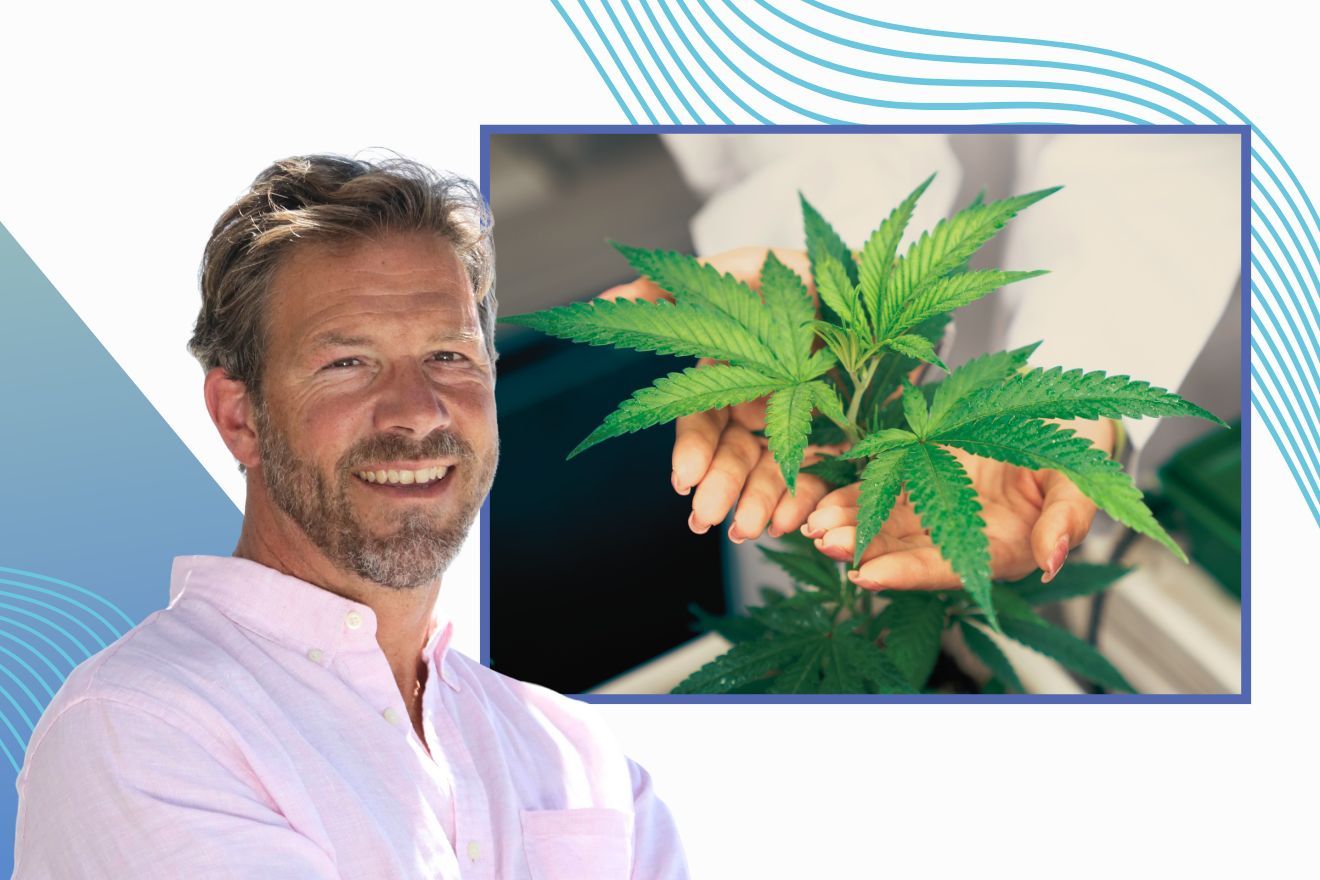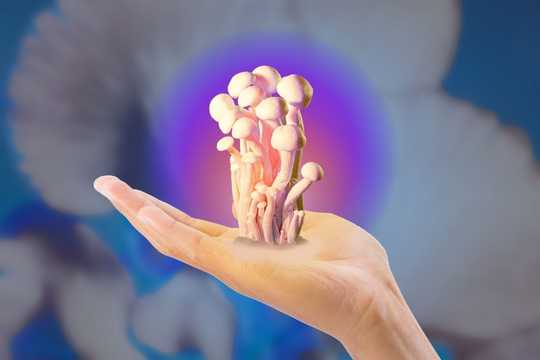Do you know what your body’s most densely populated receptor system is? It is the Endocannabinoid System (ECS). We spoke with Dr Jake F. Felice, ND, LMP, about this fascinating system that maintains physiological balance and responds to different types of pain.
“Just about everywhere we look from health, the spectrum of health to pathology, the endocannabinoid system is involved in all of these processes.”
— Jake F. Felice, MD
Dr. Jake offers elite education on natural health, flow states, and whole-body wellness. He is an author, clinician, educator, and consultant dedicated to advancing global natural medicine. Raised in Western Pennsylvania, he excelled at Penn State University, majoring in psychology and playing varsity lacrosse.
His passion for Asian cultures led him to study shiatsu, aikido, and tai chi in Japan for five years. He followed this with a year-long exploration of traditional healing arts in Thailand, Nepal, and India. Dr Jake’s educational materials promote a connection with nature, enhance human potential, and highlight botanical therapeutic properties. They have translated his Category 1 CME courses on the ECS into four languages. As the founder of Sweetwater Holistic Consulting LLC, he focuses on coaching flow-state access for high-performing individuals. He also advises dietary supplement and cannabis companies on product development.
Register for Dr. Jake’s Online Course: The Endocannabinoid System: Exploring Synergy and Homeostasis
Dr. Jake’s Journey Into Plant Medicines and Psychedelics
We asked Dr. Jake to share his story of how he entered the world of plant medicines and psychedelics and how he ended up having a particular interest and focus on the ECS. He recounts how a childhood experience with a plant poultice sparked his interest in plant medicines, leading to a fascination with cannabis and psychedelic exploration. Dr. Jake shared:
“I learned about plants from a very early age. I was a little kid at summer camp, and I got stung by a bee on my hand…one of my camp counselors made a poultice of a plant that was right there in the area. The name of the plant is called Plantago officinalis. And I remember the plant to this day, and every time I see it, I still remember it. She put that on my hand, and very quickly, I was surprised…the pain went away, and it never left me. I’ve used this plant since for stings.”
Dr. Jake’s Interest in Cannabis
Dr. Jake shared that he’s always had an interest in cannabis. He thinks his personality type has a bent toward psychedelic exploration as a caveat. He read books about it In high school, including those written by Timothy Leary. It made him very interested in altered states, how they may help us, and how they’re similar to meditative states. He shared that he approaches cannabis as an individual on a personal level.
Dr. Jake explains how his patients’ use of medical cannabis prompted him to delve into research and eventually become involved in authorizing legal cannabis use. He had two patients in a row take themselves off of the exact same benzodiazepine, which is in the same class as Valium. When the first patient told him that it was cannabis that helped them get off this medication, it didn’t fly with Dr. Jake. But the next patient said something different. Dr. Jake shared:
“But the very next patient said cannabis. And the difference in the word structure alerted me. I started doing some research. I’d always been interested in, but not on a medical level, but on more of a spiritual level.”
Follow your Curiosity
Sign up to receive our free psychedelic courses, 45 page eBook, and special offers delivered to your inbox.At the time, many people were asking him questions about this plant. Eventually, he started writing authorizations for legal cannabis. These authorizations occurred before the recreational laws came into place. Then Dr. Jake began getting invited to give speeches at the co-ops that were around. And that was the beginning of his journey.
What is the Endocannabinoid System (ECS)?
Dr. Jake explained that the ECS is intricate and complex, so it’s hard to describe it simply. Instead, he provided a helpful analogy that compares it to the body’s communication network.
Internet of Our Body
Dr. Jake shared that the ECS is like the Internet of our body; it’s a vast communication system that cells use to talk to each other. The cells are the individual cell phones or computers. The network is the interstitial connective tissue. The human nervous system has more cannabinoid receptors than any other particular type of receptor. We can think of biology as being stingy. For instance, we don’t create these receptors because they’re not necessary or not being used, but we use all of them for communication purposes.
Dr. Jake gave an example of being on a Zoom call. If someone’s connection is bad, their video or audio might not come through. When the network in our body is bad, many different types of pathology alter our ECS. Communication between the different cells, organs, or organ systems.
How the ECS Helped Life Invent Bodies
Dr. Jake shared that another way he likes to think about the ECS is by understanding what was happening biologically at the beginning of life. Life began producing organisms with bodies or multicellular organisms six hundred million years ago. If we think of the ECS as a system that helped life invent bodies, that’s exactly what it does.
ECS Role in Embryonic Development, Food Delivery and Repair
Dr. Jake elaborates on the ECS’s role in embryonic development, food delivery, and recognizing damage and repair processes within the body.
He compared a body to a single cell. The body needs a blueprint and a template to go from the sperm and the egg meeting to having a liver, kidneys, lungs, heart, brain, and so forth. Those cells need to know how to change from a single cell to two to four. The endocannabinoid system intimately governs the whole embryologic process.
What does a body need that a single cell doesn’t? It requires a way to transport food and energy to various parts of the body and deal with waste products. So, the food drive and food dynamic are essential.
If we give newborn mice a drug that blocks the endocannabinoid system, they don’t know how to suckle. Their muscles required to get the milk from the mom don’t work. If we go back even further, that bunch of cells, when it’s about to be implanted into the womb, into the endometrium, to establish blood supply, we block the endocannabinoid system, none of that happens.
The ECS recognizes damage and repair processes within our body. It does the communication piece and assists in the mobilization. Dr. Jake explained:
“So by endocannabinoid system, I’m not saying cannabis does all of this, but that the endocannabinoid system itself is involved in all of these processes. So that’s why it has so many potential applications through so many disease processes because it’s working with the informational deep structure of biology, as opposed to what we classically think of as a nervous system or a digestive system.”
ECS Role in Maintaining Physiological Balance
We asked Dr. Jake to explain the endocannabinoid system’s role in maintaining physiological balance and responding to different types of pain.
Understanding Homeostasis
Homeostasis is the dynamic balance. Two people are sitting, and their body temperatures aren’t exactly the same, but they’re above the normal temperature of the room because humans are warm-blooded creatures. Dr. Jake provided an easy way to understand homeostasis. Dr. Jake explained:
“You get in your car, and it’s hot outside, the air conditioner comes on. Or if it gets cold outside, the heater turns on. So, we have biological oscillators and mechanisms that can tell if our temperature is too high or if it’s too low. When you hit that auto button in your car to regulate the temperature, our biology does the same thing. If it’s too warm, an opposite effect happens if it’s too cold, and that’s called negative feedback.”
Homeostasis is negative feedback in multiple areas that keeps us intact and together. It keeps our heart at the right rhythm, breathing at the right rate, and temperature correct. Our biology is doing an immense amount of calculations at any given time.
Essential Reads on CBD and Psychedelics Therapies:
- Learn How Cannabis-Assisted Psychotherapy Can Help You Weed out the Best From the Rest
- What Happens When You Combine CBD With Psychedelics? Find out About the Therapeutic Benefits
- Join Us as We Compare Psychedelic Therapy and Medical Cannabis in the Tree of Plant Medicine
- Wondering if CBD Oil for Mental Health Is Right for You? Learn About These 5 Benefits
ECS: A Sensor and Corrective Element
Dr. Jake explains the concept of homeostasis and how the ECS functions as a sensor and corrective element to ensure the body’s integrity despite external challenges. The endocannabinoid system governs much of our homeostasis. The ECS is involved in receptor populations in different organs or tissues that come online or offline to our body, making its own endocannabinoids. Dr. Jake explained:
“Just about everywhere we look from health, the spectrum of health to pathology, the endocannabinoid system is involved in all of these processes.”
Another way to think about it is that your body is a castle, and the elements of chaos in the world are dragons or invading bacteria. The body has to maintain its integrity despite a chaotic world. The ECS is not only the sensor for what’s going on and what’s wrong but is also the corrective element for how long to bring resources to this particular area to ensure that we stay intact, maintaining homeostasis.
ECS and Pain Management
We asked Dr. Jake to discuss the ECS from a pain perspective. He delves into the mechanisms by which cannabinoids affect pain signaling and inflammation, particularly in the context of tension migraines and muscle soreness.
Migraines and Cannabis
Dr. Jake shared that THC and CBD are cannabinoids that can influence how the nerve transmits pain. He provided an analogy of a Bluetooth speaker. There are two places to control the noise signal of the speaker: a phone or you can turn the volume up or down on the speaker itself.
Our nerve and pain conduction goes along nerve routes. The endocannabinoid system can turn the volume of the pain signal down. It’s called retrograde inhibition. For example, topical cannabis products would be like turning that volume down on the Bluetooth speaker for tension migraines or muscle soreness.
Anti-inflammatory and Muscle Relaxant Effects of Cannabinoids
Dr. Jake explained that all cannabinoids have anti-inflammatory effects. This effect turns down chemical mediators in the system that can aggravate and exacerbate pain. During a migraine, spasms of the brain’s blood vessels occur. Cannabinoids such as CBD and THC can relax the smooth muscle and help improve blood flow. Dr. Jake explained:
“[Cannabinoids are] working on the transmission level….relaxing the vasculature to increase blood flow, and it’s working on an anti-inflammatory pathway. Instead of hitting one biochemical target, as a conventional drug would, it is hitting multiple areas at the same time.”
Endocannabinoid System and Holistic Health Practices
Dr. Jake shared the connection between holistic health practices such as dietary interventions, acupuncture, and singing and their impact on the ECS. He has long been interested in the relationship between conventional medicine, complementary medicine, and the endocannabinoid system.
Dietary Interventions
Dr. Jake explained that most of the things we think of as natural and healthy, such as a balanced diet, have been shown to help the ECS. Dr. Jake explained:
“I like that I can use the endocannabinoid system as an educational tool, not to promote cannabis but also to promote a healthy diet and lifestyle. Essential fatty acids, omega-3s, help the endocannabinoid system. Probiotics actually use endocannabinoid-like molecules to communicate with our immune system.”
Aside from cannabis, other plants that affect the endocannabinoid system include echinacea and kava kava.
Dr. Jake shared that other practices supporting the ECS include singing, acupuncture, and chiropractic-type manipulations.
CBD, THC, and Endocannabinoid Availability
Dr. Jake explained how CBD modulates the effects of THC and enhances the availability of endocannabinoids in the body. CBD lands on an inactive part of the cannabinoid receptor called CB1. When it lands on the inactive part, it changes the shape of the receptor that THC lands on. Therefore, CBD modulates not only THC but also how our endocannabinoids work on that receptor system.
He shared that studies are showing some of the adverse effects of THC, such as short-term memory loss, can be mitigated to a degree by using CBD because it’s landing on a different part of the receptor, changing how it works.
Dr. Jake shared a pharmacologic way that CBD affects the ECS. Our body makes endocannabinoids that run on the ECS. CBD reduces the enzyme that breaks them down. Therefore, by decreasing the amount of these enzymes, CBD can make the endocannabinoids last longer in the system, increasing their availability.
Therefore, the field of research looking into the ECS is growing. The more we learn about the ECS, the better we can understand how our bodies work and how to optimize health and well-being.
Connect With Dr. Jake:
- Visit his site: Sweetwater Holistic
- Register for Dr. Jake’s Course: The Endocannabinoid System: Exploring Synergy and Homeostasis







